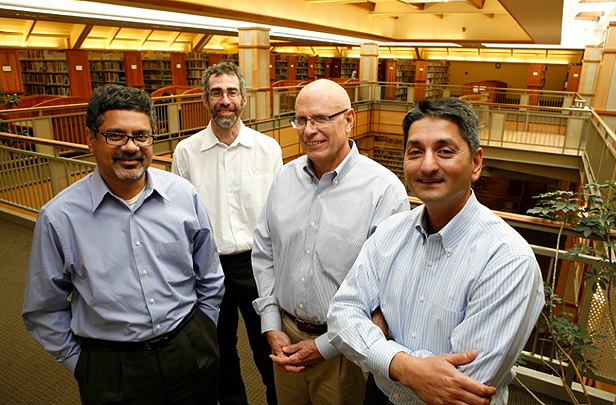The First Fuel Is Efficiency

Patrick Goddard doesn’t like energy audits. For him, as director of facilities for the town of Lexington, Massachusetts, an audit means a day spent walking around one of 22 buildings owned by the town, peering at insulation on windows and finding the keys to the HVAC room.
Worse, auditors “don’t understand how the buildings operate,” Goddard complains. “They see it at one point in time and do an analysis on what they see.” Usually, their report comes back weeks later recommending more equipment, new windows, or more insulation.
So when a Lexington resident named Swapnil Shah approached Goddard at a meeting of the town energy committee and asked if the town was interested in a “virtual” audit, Goddard said yes.
He gave Shah a year’s worth of data from the electricity meter of a town building. A few hours later, Shah sent Goddard a report showing that the building seemed to be using nearly as much energy after hours as during the day, suggesting it wasn’t getting shut down properly. Eventually, Shah examined seven of Lexington’s buildings and discovered problems that an auditor might have missed—for example, that the library’s heating system was powering up at 4 a.m., hours before staff arrived in the mornings.
It was “absolutely better” than an on-the-ground audit, says Goddard, who expects simple efficiency fixes to save him $90,000, or about 3 percent of his annual operating budget.
Shah’s startup, FirstFuel, finds these savings thanks to a combination of analytical software, building expertise, and so-called interval meters that utilities have begun putting in place. These smart electricity meters update as frequently as every 15 minutes, capturing tens of thousands of data points each year where the old, monthly-read meters captured just 12.
Along with data from the new meters, all FirstFuel needs to start an audit is a building’s address. The company determines the hourly local temperature and precipitation and gets satellite imagery to determine a building’s shape and position relative to the sun. Combining those data, its software is able to deduce what’s been happening inside a building, spitting out a description of how it consumes electricity across nine categories, including cooling, electric heating, lighting, pumps, and plug usage.

Robert Kaufmann, a Boston University professor and cofounder of FirstFuel, is cagey about exactly how the analysis works. But he and his colleague Nalin Kulatilaka say they combine techniques like regression analysis and neural networks to predict a building’s characteristics.
Their statistical models were fine-tuned through lengthy discussions with Ken Kolkebeck, a building engineer who is also among FirstFuel’s cofounders. He helped Kaufmann and Kulatilaka understand which results mattered in their models. “Without Ken, we’d be drowning in data,” Kaufmann says.
Humans are still involved in aspects of the business like recommending specific steps to take to lower energy use. But thanks to the data crunching, the whole process takes just a few hours, and FirstFuel says it can analyze about half a dozen buildings a day. It expects to nearly double staff this year following a $10 million venture capital round announced in February. Overall it has raised $12.4 million.
The company’s plans fit into a wider recognition that efficiency could play a giant role in meeting energy needs. Buildings account for around 40 percent of all energy use in most countries. Yet in many commercial buildings, 20 percent of energy is simply wasted by leaving lights on or running heat and cooling simultaneously.
Tools like FirstFuel’s won’t replace physical audits entirely. Instead, the software is more likely to be a fast way to screen for problems. The company is starting to work with some utilities in hopes of providing automated reports based on meter data to all their big clients.
“It means you can show [building managers] the problems they have,” says Mary Ann Piette, head of the building technologies and urban systems department at Lawrence Berkeley National Laboratory. “The first step is awareness.”
In Lexington, Patrick Goddard says he’ll be adding interval meters to more town buildings. “Now you get the bill every month and you’re trying to figure out what happened,” he says.
Keep Reading
Most Popular
Large language models can do jaw-dropping things. But nobody knows exactly why.
And that's a problem. Figuring it out is one of the biggest scientific puzzles of our time and a crucial step towards controlling more powerful future models.
The problem with plug-in hybrids? Their drivers.
Plug-in hybrids are often sold as a transition to EVs, but new data from Europe shows we’re still underestimating the emissions they produce.
Google DeepMind’s new generative model makes Super Mario–like games from scratch
Genie learns how to control games by watching hours and hours of video. It could help train next-gen robots too.
How scientists traced a mysterious covid case back to six toilets
When wastewater surveillance turns into a hunt for a single infected individual, the ethics get tricky.
Stay connected
Get the latest updates from
MIT Technology Review
Discover special offers, top stories, upcoming events, and more.